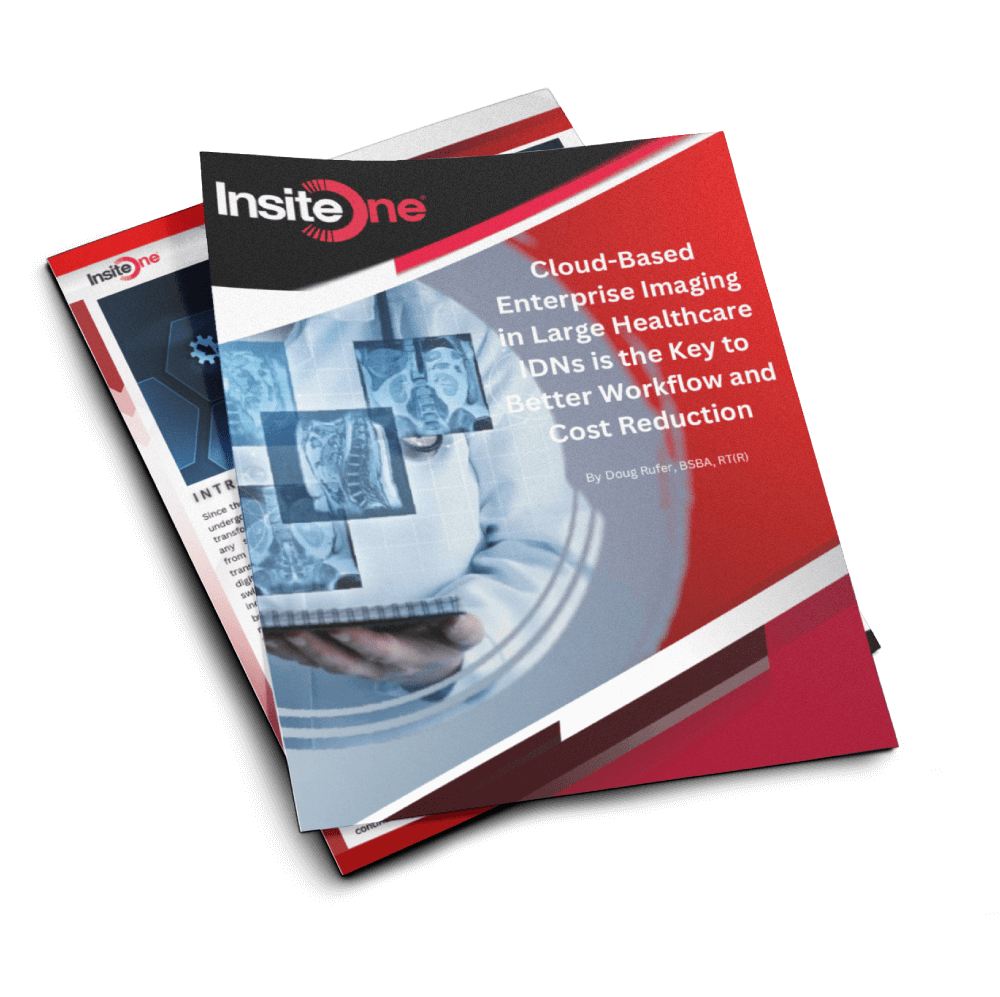Navigating Enterprise Imaging: 10 Mistakes to Avoid for Success

Introduction
Enterprise Imaging (EI) is a cornerstone of modern healthcare organizations today but there are 10 mistakes you should avoid for success. Transforming the way medical images are captured, stored, shared, and interpreted, EI is being adopted more and more every day. In fact, several factors are responsible for propelling Enterprise Imaging solutions as the preferred foundation for all imaging in the future, including:
- Scalable storage and IT consolidation among disparate departmental systems
- Hospital acquisitions (from many solutions to one)
- Enterprise focus (remove data access barriers and ensure long-term enterprise goals are met instead of short-term departmental needs)
- Interoperability among clinical data within the patient’s electronic health record (EHR)
However, even successful enterprise imaging implementations face challenges you must overcome. When you establish a sound strategy early in your EI journey, you will improve your implementation process and achieve your desired outcomes sooner.
In this blog, we explore 10 common mistakes you must avoid and provide guidelines for actionable strategies to take to achieve success in your EI rollout.
Mistake #1: Neglecting Comprehensive Planning
A common mistake when starting an EI initiative is rushing into vendor selection and starting an implementation without a well-defined strategy. Many stakeholders in your organization will be impacted by your EI solution. This makes it very important to gain insight and feedback from your key stakeholders early in your process. Without early planning, understanding the needs and concerns of your key stakeholders will be missed.
Solution: Build a roadmap and timeline detailing which departments will convert first to the enterprise platform. Consult with your key stakeholders early in your discovery and planning process to capture their needs and goals, then align them with your rollout timeframe. Be sure to include who your key stakeholder champions are, the resource allocations required, planned training initiatives, as well as potential roadblocks. Engage all relevant departments to ensure comprehensive alignment and address those concerns early in your planning. You will not cover 100% of every issue but early planning ensures greater adoption and long-term success.
Mistake #2: Overlooking Interoperability
Healthcare organizations have been notorious adopting solutions that solve short-term needs without appreciating how those decisions affect the enterprise. This stems from the siloed approach of system implementations that has plagued healthcare for decades. When EHRs were being adopted, along with new care models (i.e., value-based care), organizations recognized the importance of greater cross-team collaboration to better manage patient health. Not understanding your enterprise needs and how technology will integrate with other systems is a critical mistake to avoid.
Solution: Prioritize interoperability early in your EI journey. Choose solutions that adhere to common industry standards (such as HL7, FHIR, DICOM, API, and others) and providing high levels of flexibility increases success with data exchange and integration. Data standardization along with strong governance policies will help ensure better long-term success with lower costs.
Mistake #3: Underestimating Storage Needs
Aging populations are increasing imaging study volumes because diagnostic tests are critical in most patient care plans. Add digitization of other “ologies” (such as digital pathology, ophthalmology, etc.), and you will need a flexible EI solution that accommodates various enterprise workflows and file outputs. Organizations often underestimate the volume of medical images they will generate over time, which can unexpectedly increases costs when the time comes to scale your storage infrastructure.
Solution: Choose an EI solution where cloud storage is part of the infrastructure. Vendors like InsiteOne can provide local cache for fast image access and improved workflows while cloud-storage is infinitely expandable to accommodate future needs. Cloud solutions enable greater capabilities to scale as your needs change and imaging volume grow. Carefully consider current and future imaging data requirements and invest in scalable storage that grows as you grow. Finally, work with vendors that can help you appropriately plan so your long-term storage costs can remain under control.
Mistake #4: Ignoring Data Security
Many organizations want control of their data in their own data centers. They believe that in-house data centers provide better protection against losing or exposing sensitive patient data. Hospitals are experts in caring for patients, not managing data centers, and often will underestimate the costs and time required to properly ensure safeguards are in place to monitor for cybersecurity breeches. When implementing an EI solution, choose a vendor that has rock solid storage capabilities and a strong history of protecting sensitive patient data.
Solution: InsiteOne manages about 40 billion clinical objects safely every day for decades. Cloud-based EI solutions, like InsiteOne, often has higher security parameters in place over traditional hospital data centers, and we are experts at keeping data safe, secure, and available 24×7. Tools in our data centers provide proper encryption, access control, and extensive audit trails, as we go to great lengths to comply with privacy and HIPAA regulations while ensuring your data is always safe.
Mistake #5: Disregarding User Training
Implementing an enterprise imaging solution impacts many users across your organization. Users may not intuitively understand how to use new technology, grasp the positive impact this technology will have on the organization, embrace new workflows, nor understand where to get help. Proper training must be planned before beginning any implementation for the highest level of user adoption with the new technology.
Solution: Early planning wins the day. Make sure end users have access to learning sessions well in advance of system implementation. Work closely with your stakeholders to gain buy-in for new workflows that will be rolled out, then have them evangelize the benefits with their staff. Send out monthly updates to all users and stakeholders on the progress of the project. Communicate how it EI will positively impact patient care and improve enterprise workflow. Finally, share information and learning with everyone on multiple outlets to meet different learning needs (YouTube videos, internal websites, internal messaging, departmental meetings, audio blogs, etc.). Make sure you uncover all stones and provide comprehensive information and training to all users to ensure efficient and effective use once your EI solution goes live.
Mistake #6: Not Addressing Workflow Integration
One way to ensure failure when implementing an EI solution is not fully understanding the workflows you will be modifying or replacing. When Meaningful Use was rolled out to drive EHR adoption, vendors raced to keep solutions in compliance with government regulations at the cost of improving workflows. This caused clinician angst over using the EHR and resulted in higher incidents of burnout and frustration. Disrupting existing workflows will ensure your EI rollout will be fraught with frustration and setbacks.
Solution: Communicate early and often. Look for ways to improve clinician workflow with your new technology. Do not disrupt clinician workflows without educating them why the change and benefits the organization will achieve. Involve your clinicians and clinical staff early in your planning stage on workflow design. Make sure new workflows integrate with their daily routines while improving their efficiency. In the long run, this reduces stress, alleviates burnout, and ensures your clinicians will better adapt to your EI solution.
Mistake #7: Failure to Standardize Protocols
Failing to enforce data governance, data standardization, and create standardized imaging protocols, leads to inconsistencies in data exchange and usage. This can limit the value and potential your data can provide in the future. Image quality and interpretations that may be less accurate can impact quality patient care. The importance of data governance in any EI initiative cannot be overstated enough. Lack of data governance and data standardization will cause long-term downstream challenges that can limit the effectiveness your new EI solution can provide on improving patient outcomes.
Solution: Develop and enforce data governance, data standardization, and standardized imaging protocols. This will ensure data consistency, accuracy, and improve cross-departmental collaboration, communication, and data exchange. Data governance is your set of processes all will follow to ensure important data assets are formally managed throughout your enterprise. Your end users can then trust the data they are using and seeing is accurate. Creating an organizational culture that adheres to data governance and data standardization will pay great dividends in the future. Establish data governance teams early on that will lead these initiatives within your organization, as this is critical to the long-term success of your EI solution.
Mistake #8: Forgetting About Future Scalability
Technology advances are an industry given and your EI solution can help you adopt new technology when it becomes available. Failure to plan for growth, as well as challenges experienced by radiologist shortages can also cause future problems. Not being flexible can catch you off-guard should you need to pivot in the future.
Solution: Choose an EI solution that is flexible, open, and can easily accommodate new industry data communication standards, new modalities, and increased patient volumes. Solutions that provide an open framework, adaptable workflows, and dynamic scaling helps accommodate future needs in clinician workflows while addressing storage growth.
Mistake #9: Lack of Change Management
Underestimating the resistance to change that staff members will experience is a mistake to avoid. Your users will be moving from traditional imaging workflows to new enterprise workflows, and this causes apprehension. People are resistant to change, and your new EI solution may be met with resistance somewhere in your organization. Preparing and planning early on will go a long way in ensuring your long-term success.
Solution: Adopt a committee of key stakeholders early in your planning phase to address resistance. Make sure to implement and enforce a robust change management policy to guide everyone. Address user concerns, provide frequent and on-going communication, and offer frequent education to users on the solution benefits. This will ultimately help your change management process. Early planning, education, and involvement of key personnel, along with detailed planning for how to address resistance goes a long way in ensuring your EI rollout is a success.
Mistake #10: Neglecting Continuous Improvement
Enterprise Imaging is a foundational organizational change in how clinical data will be acquired, managed, accessed, and analyzed going forward in your organization. You are moving away from short-term departmental needs to long-term organizational strategies that can impact and affect patient care for the better. Adopting an EI solution is a long-term journey that never really ends, requiring constant change and continuous improvements.
Solution: Be sure to establish mechanisms for continuous evaluation and improvement in your solution rollout. Include feedback loops, use of data analytics, and regular system updates to keep your system fresh, up to date, and ready for the next hurdle. Enterprise Imaging is a long-term journey and along the way, technology updates, new imaging solutions and techniques, political and policy changes, research opportunities, and on-going analysis of insights from your data will become available. Constant evaluation and planning for change ensure you receive the maximum benefit and largest return on investment for your organization well into the future.
Conclusion
Successful enterprise imaging implementations require early stakeholder buy-in and careful planning throughout the selection and implementation process. Therefore, a commitment from all key stakeholders to embrace interoperability and security demands while providing extensive and frequent user-focused training helps ensure adoption and rollout success. Finally, do not forget workflow integration and optimization that fits the needs of your users as well as a commitment for continuous optimization and improvement. By avoiding these common mistakes and adopting system modernization with a strategic solution in enterprise imaging from InsiteOne, your organization can unlock the full potential and benefits that enterprise imaging has to offer, while improving patient care and maximizing operational efficiencies.




